Characterization of Slurry Sedimentation and Microstructure in Immersed Tube Tunnel Trenches: A Case Study of the Tanzhou Waterway Dredging Strategy
Abstract
1. Introduction
2. Materials and Methods
2.1. Field Sampling and Soil Characterization
2.2. Experimental Design
3. Soil Sedimentation Test Results
3.1. Settlement Time-Dependent Characteristics
3.2. Variation Patterns of Settlement Rate
3.3. Distribution of Water Content in Sediments and Its Temporal Variations
4. Microscopic Characteristics of Sediments
4.1. Microstructural Evolution with Sedimentation Time
4.2. Microstructural Comparison of Various Soil Sediments
5. Discussion
5.1. Comparative Analysis with Prior Studies
5.2. Mechanistic Interpretation
5.3. Limitations and Future Work
6. Conclusions
- (1)
- The settlement behavior of silty clay and mucky soil slurries can be categorized into two distinct types: consolidation settlement and hindered settlement. Consolidation settlement curves are characterized by an inverse “S” shape, while hindered settlement curves exhibit pronounced three-stage features (flocculation, sedimentation, and consolidation stages). Experimental results demonstrate that silty clay slurry primarily shows consolidation settlement at lower initial heights (10–20 cm) but transitions to hindered settlement behavior at greater initial heights (40–60 cm). In contrast, mucky soil slurry consistently displays hindered settlement characteristics across all tested initial conditions. The strong positive correlation between the duration of hindered settlement and initial slurry height confirms that settling distance is the primary determinant of settlement stage duration;
- (2)
- The settlement rate of silty clay slurry depends on both initial height and unit weight, with low-unit-weight (11.5 kN/m3) slurries at high initial heights (40 cm, 60 cm) showing significantly higher settlement rates compared to other conditions. In contrast, mucky soil slurry exhibits more consistent settlement behavior, with a clear decreasing trend with increasing initial height. However, when the unit weight reaches 12.0 kN/m3, the effect of initial height on settlement rate becomes less pronounced;
- (3)
- The water content evolution of silty clay sediments shows temporal stability, with low-unit-weight slurries (11.5 kN/m3) showing considerable data variability, whereas high-unit-weight specimens (12.6 kN/m3) display characteristic slow drainage behavior typical of compacted soils. In mucky soil sediments, low-unit-weight slurries display pronounced structural instability accompanied by frequent anomalous water content readings. Specimens with a 12.0 kN/m3 unit weight show rapid initial drainage rates during early sedimentation, followed by water content recovery in later stages caused by pore water redistribution phenomena;
- (4)
- The sediment particles of mucky soil are characterized by a laminar structure, transitioning gradually from face-to-face contact in the bottom layer to face-to-edge or face-to-body contact in the upper layer. The porosity increases with sedimentation height, ranging from 45% to 50%. The pore geometry evolves from regular to complex shapes, with a shape factor of 0.35 to 0.40 indicating pore anisotropy, which stabilizes over time with prolonged sedimentation. The probability entropy suggests a highly random initial pore distribution. The rose diagram exhibits an elliptical pattern, reflecting the compaction and structural reorganization of particle arrangement. In contrast, silty clay sediments display a honeycomb-like cavity structure that diminishes with decreasing initial density, accompanied by prominent particle aggregation.
Supplementary Materials
Author Contributions
Funding
Data Availability Statement
Conflicts of Interest
References
- Wang, Y.; Zhou, H.; Min, X. Modelling the performance of immersed tunnel via considering variation of subsoil property. Ocean Eng. 2022, 266, 113114. [Google Scholar] [CrossRef]
- Yang, C.; Wang, Y.; Wei, L.; Chen, Y. Mechanical Characteristics of Variable Cross-Section Immersed Tunnels under Spatial Differential Settlement. Adv. Civ. Eng. 2022, 2022, 8357463. [Google Scholar] [CrossRef]
- Li, K.; Li, Q.; Fan, Z. Hong Kong—Zhuhai—Macau sea link project, China. In Marine Concrete Structures; Woodhead Publishing: Cambridge, UK, 2016; pp. 339–370. [Google Scholar]
- Chen, W.; Huang, L.; Wang, D.; Liu, C.; Xu, L.; Ding, Z. Effects of siltation and desiltation on the wave-induced stability of foundation trench of immersed tunnel. Soil Dyn. Earthq. Eng. 2022, 160, 107360. [Google Scholar] [CrossRef]
- Martellotta, A.M.N.; Levacher, D.; Gentile, F.; Piccinni, A.F. Estimation of Silting Evolution in the Camastra Reservoir and Proposals for Sediment Recovery. J. Mar. Sci. Eng. 2024, 12, 250. [Google Scholar] [CrossRef]
- Wu, T.; Sheng, Y.; Chen, D.; Qin, B. Synchronism of sediment erosion and deposition processes during high-turbidity events in a large shallow lake. J. Hydrol. 2023, 623, 129853. [Google Scholar] [CrossRef]
- Zhong, Y.; Du, J.; Wang, Y.; Li, P.; Xu, G.; Miu, H.; Gao, W. Modeling the Impacts of Land Reclamation on Sediment Dynamics in a Semi-Enclosed Bay. J. Mar. Sci. Eng. 2024, 12, 1633. [Google Scholar] [CrossRef]
- Chen, W.; Liu, C.; He, R.; Chen, G.; Jeng, D.; Duan, L. Stability of the foundation trench of the immersed tunnel subjected to combined wave and current loading. Appl. Ocean Res. 2021, 110, 102627. [Google Scholar] [CrossRef]
- Hussein, A.A.A.; Zhao, L.; Al-Masgari, A.A.S.A.; Handoyo, H. Shear strength characteristics of marine sediments: The influences of lithofacies and sedimentological environment. Mar. Geophys. Res. 2024, 45, 14. [Google Scholar] [CrossRef]
- Vakalas, I.; Zananiri, I. Net Transport Patterns of Surficial Marine Sediments in the North Aegean Sea, Greece. J. Mar. Sci. Eng. 2024, 12, 512. [Google Scholar] [CrossRef]
- Chondros, M.; Metallinos, A.; Papadimitriou, A.; Tsoukala, V. Sediment Transport Equivalent Waves for Estimating Annually Averaged Sedimentation and Erosion Trends in Sandy Coastal Areas. J. Mar. Sci. Eng. 2022, 10, 1726. [Google Scholar] [CrossRef]
- Zhang, S.; Tang, Y.; Zhao, Y.; Chen, Y. Experimental and numerical investigation of inverse-grading characteristics in the underwater granular deposition. Environ. Earth Sci. 2025, 84, 103. [Google Scholar] [CrossRef]
- Vasudevan, S.; Sajeev, R.; Ramakrishnan, R. Seasonal variations in textural characteristics and depositional environment of foreshore sediments along Kerala Coast, India. Mar. Georesour. Geotechnol. 2024, 42, 279–288. [Google Scholar] [CrossRef]
- Imai, G. Settling behavior of clay suspension. Soils Found. 1980, 20, 61–77. [Google Scholar] [CrossRef] [PubMed]
- Imai, G. Experimental studies on sedimentation mechanism and sediment formation of clay materials. Soils Found. 1981, 21, 7–20. [Google Scholar] [CrossRef]
- Toorman, E.A.; Berlamont, J.E. A hindered settling model for the prediction of settling and consolidation of cohesive sediment. Geo-Mar. Lett. 1991, 11, 179–183. [Google Scholar] [CrossRef]
- Ramakrishnan, B.; Gavali, M.; Jeyaraj, S. Comprehensive Analysis of Siltation Behavior in the Navigation Channel of Deendayal Port (India): Field Observations, Numerical Modeling, and Engineering Solutions. J. Coast. Res. 2024, 40, 138–149. [Google Scholar] [CrossRef]
- Gao, Y.F.; Zhang, Y.; Zhou, Y.; Li, D.Y. Effects of column diameter on setting behavior of dredged slurry in sedimentation experiments. Mar. Georesour. Geotechnol. 2016, 34, 431–439. [Google Scholar] [CrossRef]
- Yang, J.; Dai, J.W.; Wu, X.Q.; Tu, Y.; Dong, S.; Li, Q. Quantitative evaluation of the influence of siderite cements on middle-shallow reservoirs: A case study of the southern oil area in the Enping Sag, Pearl River Mouth Basin. Bull. Geol. Sci. Technol. 2023, 42, 127–136. [Google Scholar]
- Hu, S.; Yi, S.; Sun, M.; Chen, P.; Wei, C. Experimental study of compression behavior and its correlation with the microstructure of a deep-water sediment. Mar. Georesour. Geotechnol. 2025, 43, 635–645. [Google Scholar] [CrossRef]
- Oberhollenzer, S.; Hauser, L.; Baldermann, A.; Marte, R.; Tschuchnigg, F.; Schweiger, H.F.; Dietzel, M. Microstructure development in lacustrine, fine-grained sediments traced by in situ and laboratory testing. Int. J. Environ. Sci. Technol. 2024, 21, 6429–6444. [Google Scholar] [CrossRef]
- Cai, G.H.; Zhang, C.H.; Zhou, Y.F.; Li, J.S.; Poon, C.S. Mechanical behavior and microstructure mechanism of artificially stabilized marine sediment under high water content. Constr. Build. Mater. 2024, 420, 135484. [Google Scholar] [CrossRef]
- Yang, A.W.; Du, D.J.; Lu, L.Q. Study on sediment characteristics and micro-structure of soft dredger soilof Tianjin. Hydrogeol. Eng. Geol. 2010, 37, 83–87. [Google Scholar]
- Song, C.; Yang, B.; Zhang, C.M.; Zhu, B.Y.; Zhang, Z.S. Investigation of pore structure and permeability estimation models of Kongdian Formation glutenites in the Bozhong 19-6 Gasfield. Bull. Geol. Sci. Technol. 2023, 42, 274–285. [Google Scholar]
- GB/T 50123-2019; Standard for Geotechnical Testing Method. Ministry of Water Resources of the People’s Republic of China: Beijing, China, 2019.
- JTS 167-2-2009; Design and Construction Code for Gravity Quay. Ministry of Transport of the People’s Republic of China: Beijing, China, 2009.
- JTS 257-2008; Standard for Quality Inspection of Port and Waterway Engineering Construction. Ministry of Transport of the People’s Republic of China: Beijing, China, 2008.
- JTS 133-2013; Code for Geotechnical Investigationon Port and Waterway Engineering. Ministry of Transport of the People’s Republic of China: Beijing, China, 2013.
- Hu, Q.; Ma, D.Q. Research on foundation trench dredging of immersed tunnel in Shenzhen-Zhongshan Link. J. Waterw. Harbor 2023, 44, 300–304. [Google Scholar]
- SZTD D01-2019; Quality Inspection and Evaluation Standard for Island-Tunnel Engineering of Zhongshan-Shenzhen Corridor Project. Zhongshan-Shenzhen Corridor Management Center: Shenzhen, China, 2020.
- Yang, H.; Wang, R.K.; Han, X.J.; Xie, M.X. Overview of sedimentation research and innovative practice to the Hong Kong-Zhuhai-Macau Bridge Tunnel Trench. J. Waterw. Harbor 2018, 39, 125–132. [Google Scholar]
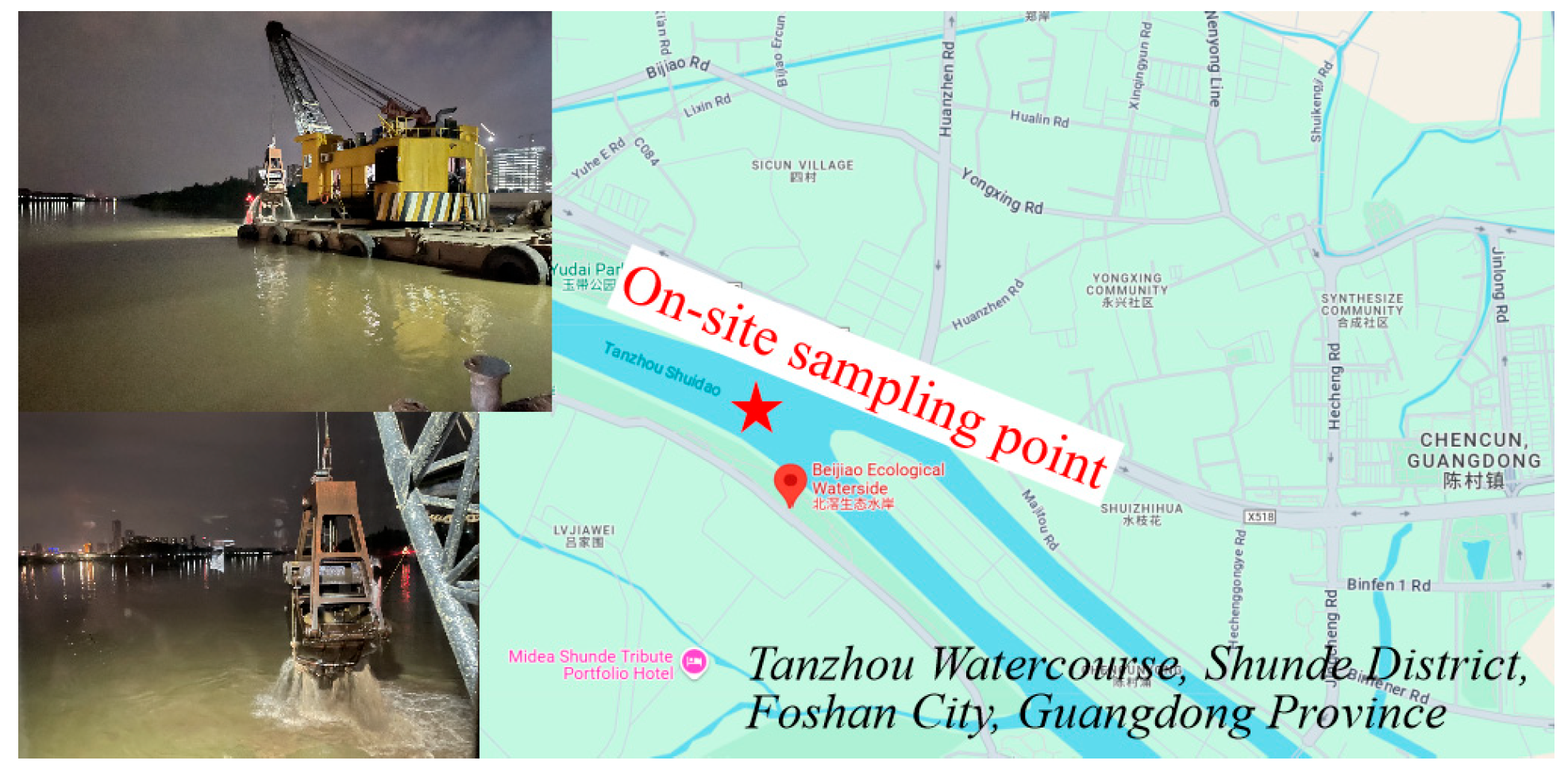

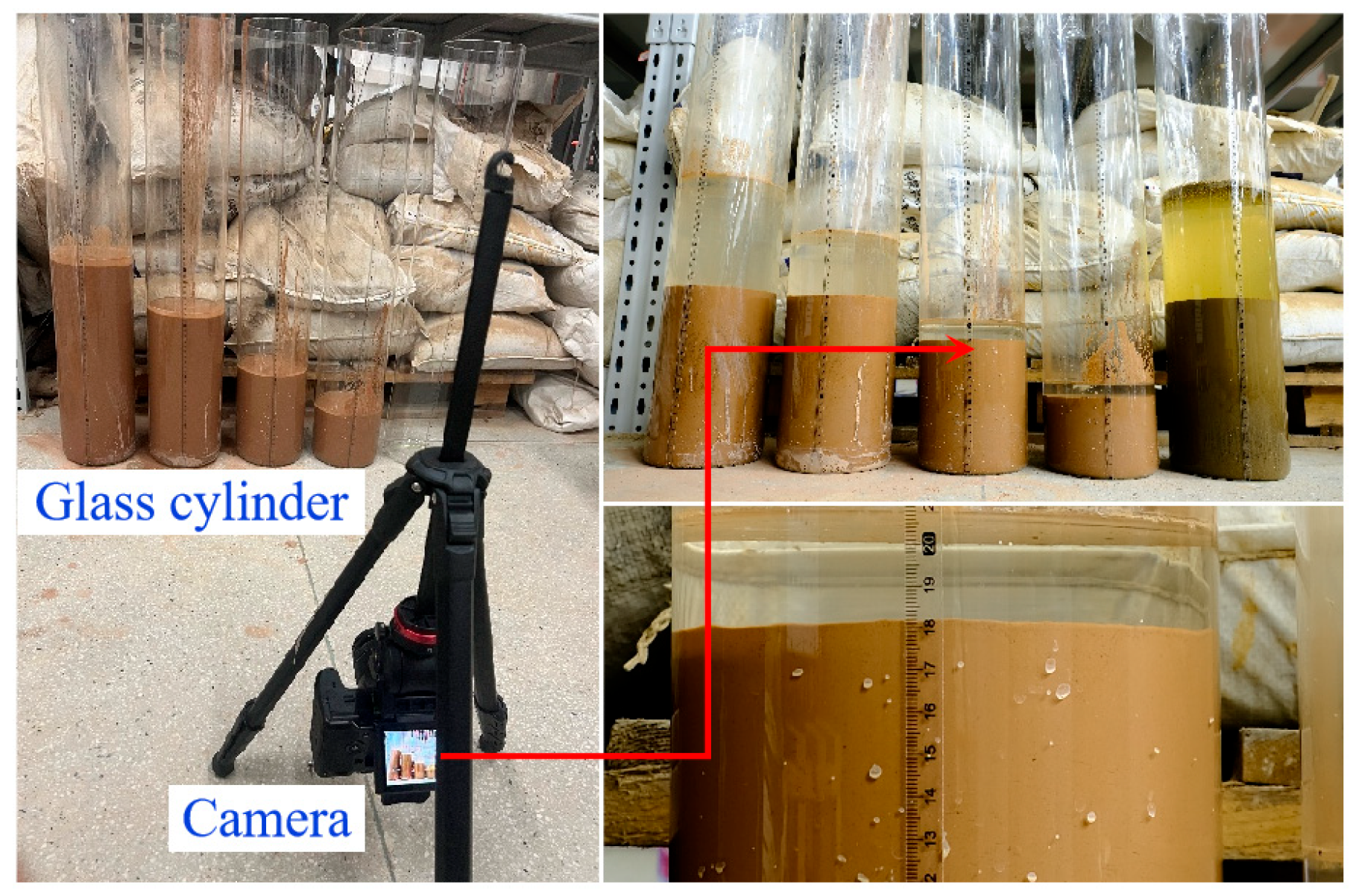
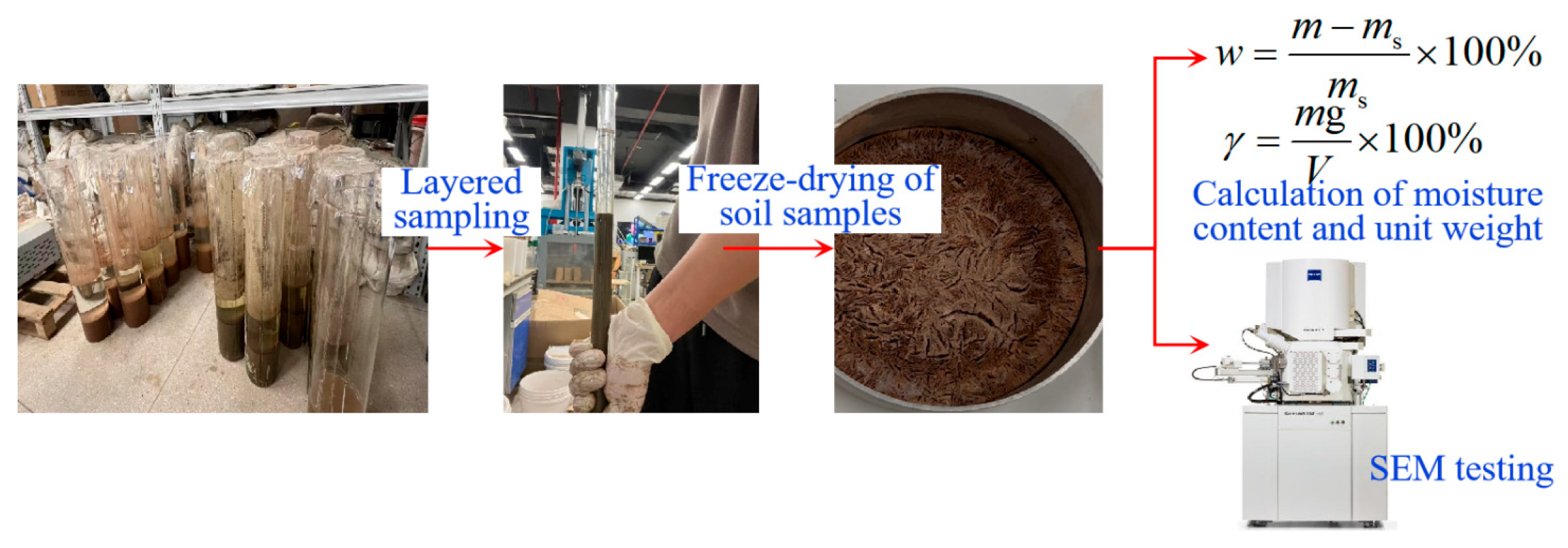
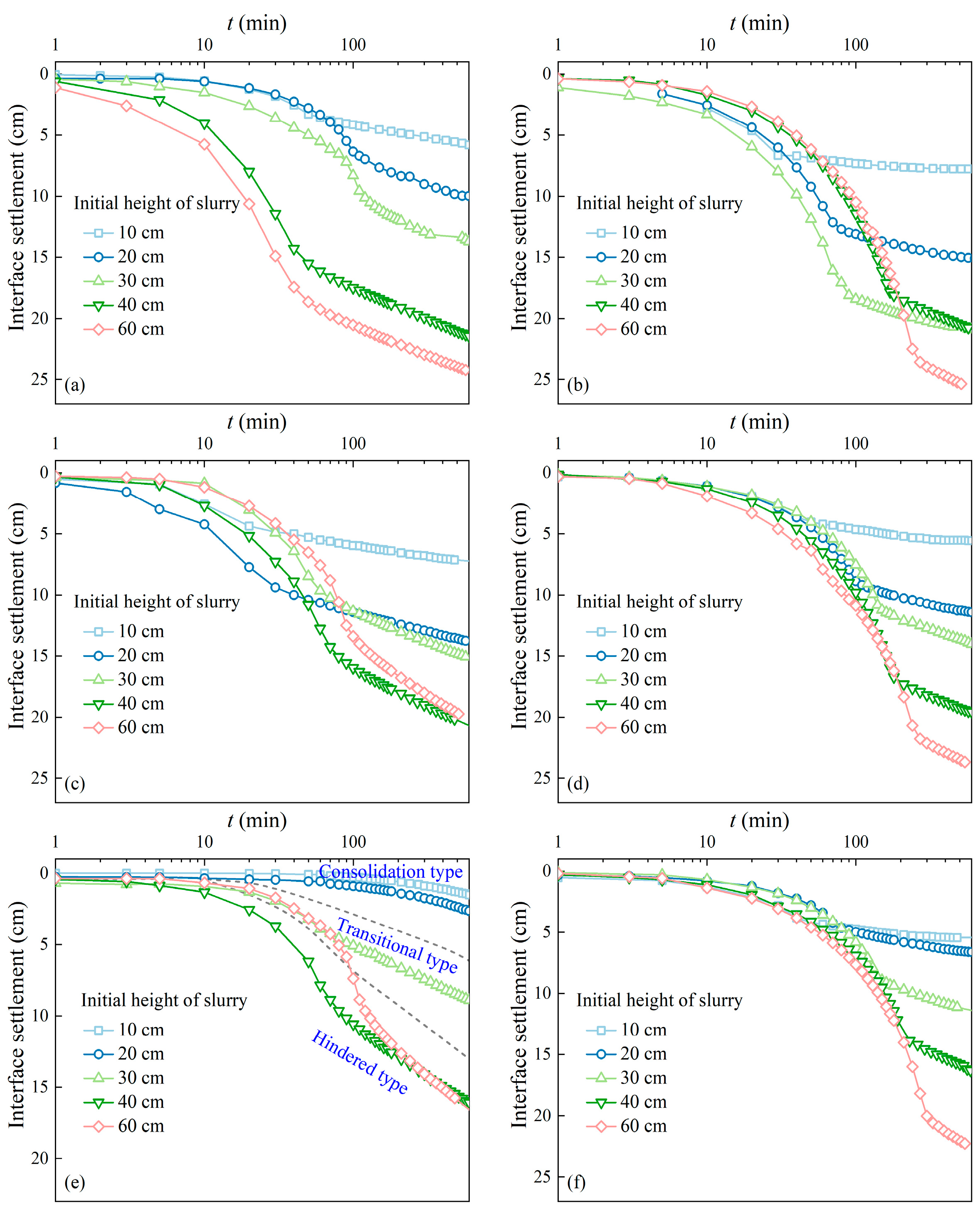



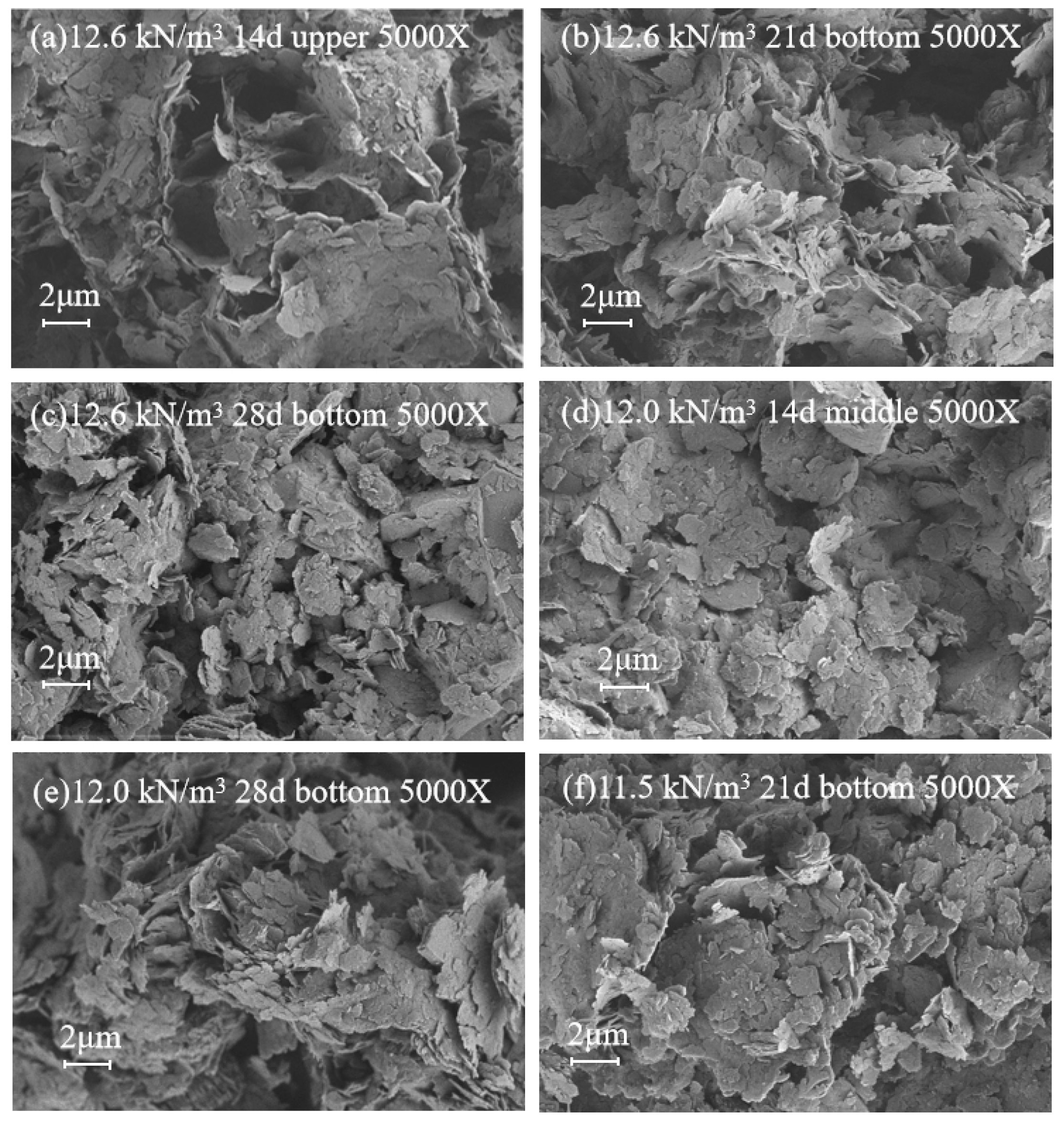
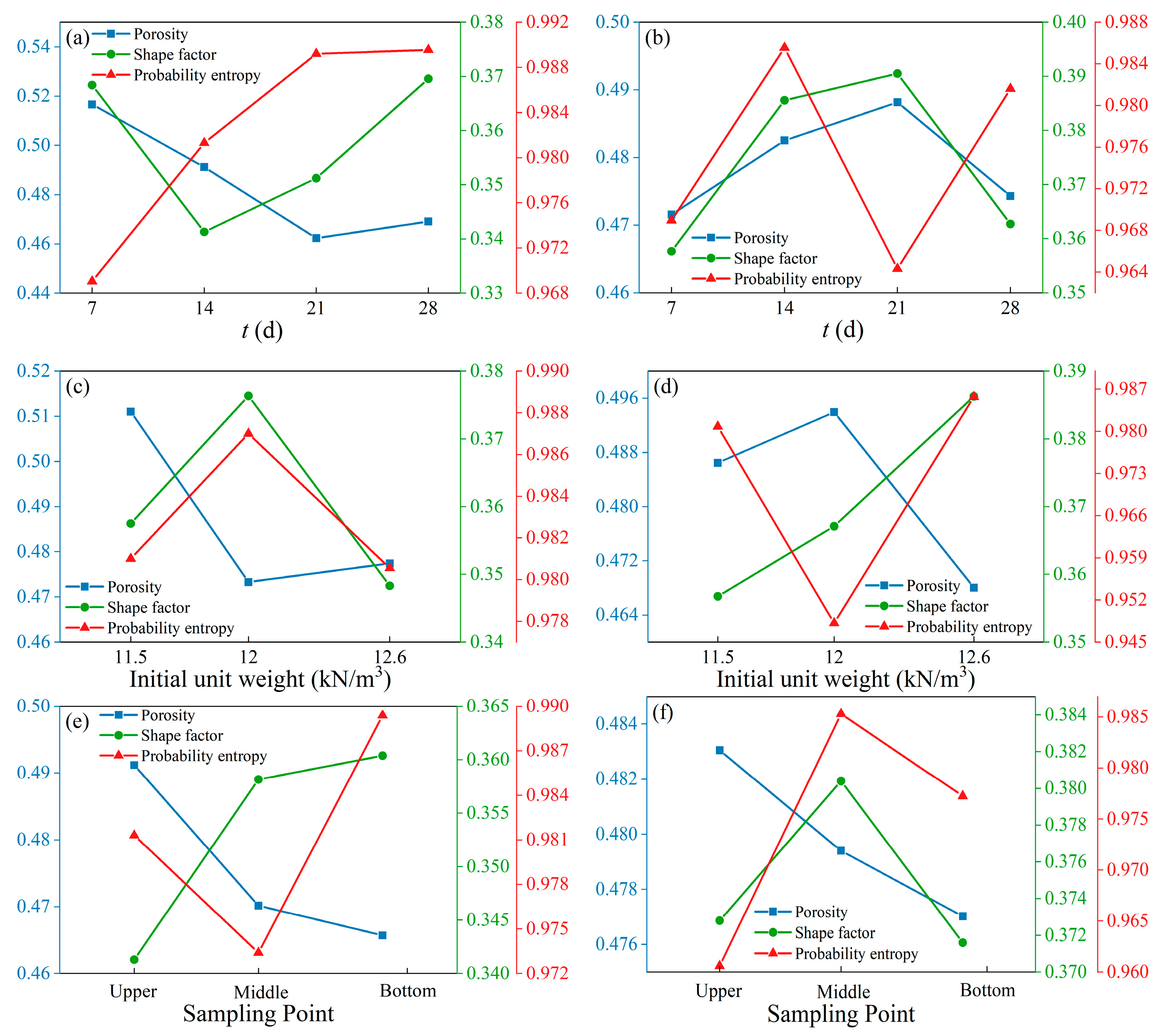

| Soil Type | Specific Gravity | Plastic Limit (%) | Liquid Limit (%) | Plasticity Index |
|---|---|---|---|---|
| Silty clay | 2.615 | 30.799 | 18.242 | 12.557 |
| Mucky soil | 2.619 | 43.002 | 24.121 | 18.847 |
Disclaimer/Publisher’s Note: The statements, opinions and data contained in all publications are solely those of the individual author(s) and contributor(s) and not of MDPI and/or the editor(s). MDPI and/or the editor(s) disclaim responsibility for any injury to people or property resulting from any ideas, methods, instructions or products referred to in the content. |
© 2025 by the authors. Licensee MDPI, Basel, Switzerland. This article is an open access article distributed under the terms and conditions of the Creative Commons Attribution (CC BY) license (https://creativecommons.org/licenses/by/4.0/).
Share and Cite
Yu, S.; Zhu, J.; Li, G.; Chang, D.; Huang, Q.; Lu, X. Characterization of Slurry Sedimentation and Microstructure in Immersed Tube Tunnel Trenches: A Case Study of the Tanzhou Waterway Dredging Strategy. Eng 2025, 6, 200. https://doi.org/10.3390/eng6080200
Yu S, Zhu J, Li G, Chang D, Huang Q, Lu X. Characterization of Slurry Sedimentation and Microstructure in Immersed Tube Tunnel Trenches: A Case Study of the Tanzhou Waterway Dredging Strategy. Eng. 2025; 6(8):200. https://doi.org/10.3390/eng6080200
Chicago/Turabian StyleYu, Shuangwu, Jingze Zhu, Gang Li, Dan Chang, Qingfei Huang, and Xingbang Lu. 2025. "Characterization of Slurry Sedimentation and Microstructure in Immersed Tube Tunnel Trenches: A Case Study of the Tanzhou Waterway Dredging Strategy" Eng 6, no. 8: 200. https://doi.org/10.3390/eng6080200
APA StyleYu, S., Zhu, J., Li, G., Chang, D., Huang, Q., & Lu, X. (2025). Characterization of Slurry Sedimentation and Microstructure in Immersed Tube Tunnel Trenches: A Case Study of the Tanzhou Waterway Dredging Strategy. Eng, 6(8), 200. https://doi.org/10.3390/eng6080200




